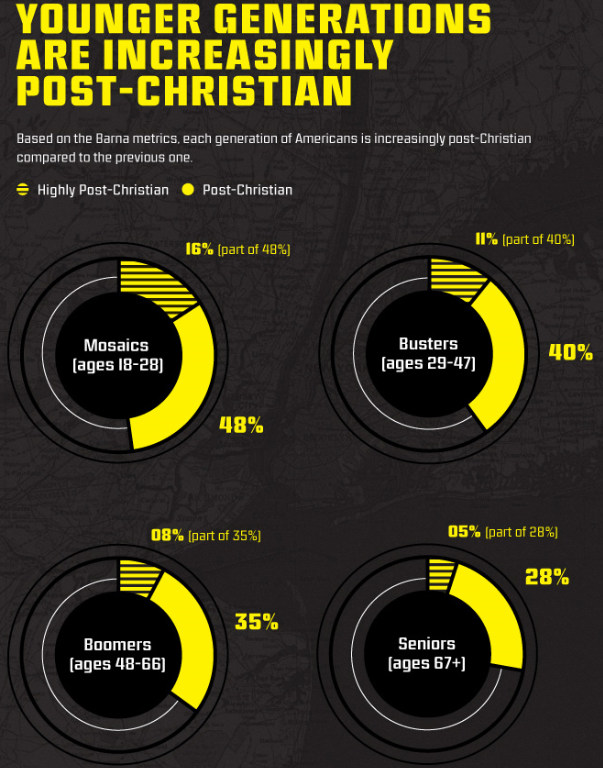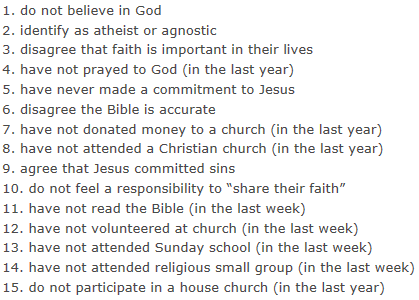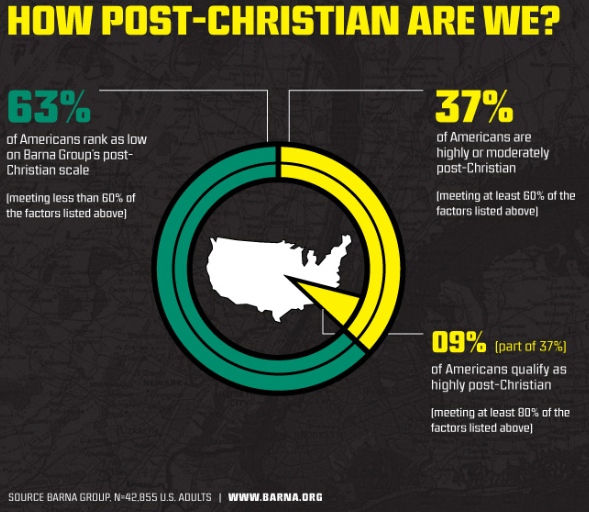The Barna group, an evangelical polling organization, presents a (rather peculiar) study which nonetheless confirms the overall relationship between younger age and lower levels of religiosity in the US.
Here is how Barna introduces the basics:
Currently, more than seven out of 10 adults describe themselves as “Christian” and more than six out of 10 Americans say they are “deeply spiritual.” Yet, just how deep do these labels go?
To shed light on this, the Barna team created an aggregate metric of post-Christian culture based upon 15 different measures of identity, belief and behavior.
To qualify as post-Christian, individuals met 60% or more of the factors (nine or more out of 15 criteria). Highly post-Christian individuals met 80% or more of the factors (12 or more of these 15 criteria).
Personally I am skeptical of these “metrics” as they appear to be arbitrary. I’d think whether or not you follow religious twitter accounts, whether or not you “like” religious Facebook pages, or how much time you spend on religious websites/watching religious TV and videos/listening to religious podcasts/radio tells a lot more about your religiosity that whether or not you attend a house church. It is possible, for example, that not asking about watching TV or listening to radio may undercount the religious people in the older age groups, whereas not asking about the digital media might undercount the younger ones. Also, what does Jesus committing sins mean? If someone disagrees with that statement does it mean they think Jesus wasn’t infallible, or does it mean they don’t believe in the concept of sin (not to mention the existence of a historical Jesus)? Likewise, the designations of “mildly” or “moderately” “post-Christian” sound rather dubious. What if you were never a Christian to begin with?
Bearing this limitation in mind, here is what their findings looked like.

It deserves mentioning that, with all the limitations in mind, their “highly post-Christian” group appears to roughly match atheist and agnostics together. For example, their numbers for this group match atheists and agnostics among the youth (13% v 16%) and general public (about 9% in both studies).
Barna people are not happy about all this.
These patterns are consistent with other studies that show the increasing percentage of “Nones” among younger generations.
There is a debate happening about how much the country is secular versus faith-oriented and whether this changes as people get older. The Barna data reminds observers that most Americans remain connected in some way with Christianity. Yet, the influence of post-Christian trends is likely to increase and is a significant factor among today’s youngest Americans.
Our research suggests that most of the efforts of Christian ministries fail to reach much beyond the core of “Christianized” America. It’s often much easier to work with this core audience, than to focus on the so-called “Nones.” The data give evidence that some cities—and younger generations—are more Gospel-resistant than the norm. In part, Christian leaders have to realize that many efforts fall short because they imagine the post-Christian population is hanging on its every word. New levels of courage and clarity will be required to connect beyond the “Christianized” majority.
Good luck with that guys. As you try to reach out to the unchurched you may want to remember that the majority of them actually grew up religious. The “problem” is not that you are not reaching out to the religiously unaffiliated. Rather, that your message no longer resonates with young people with a religious background.



